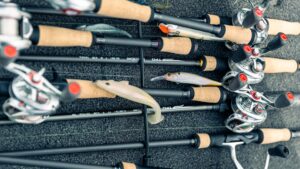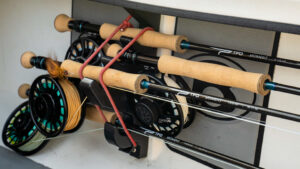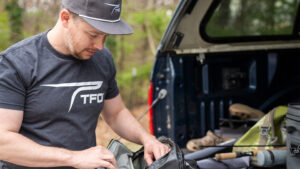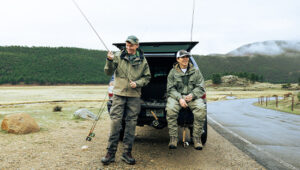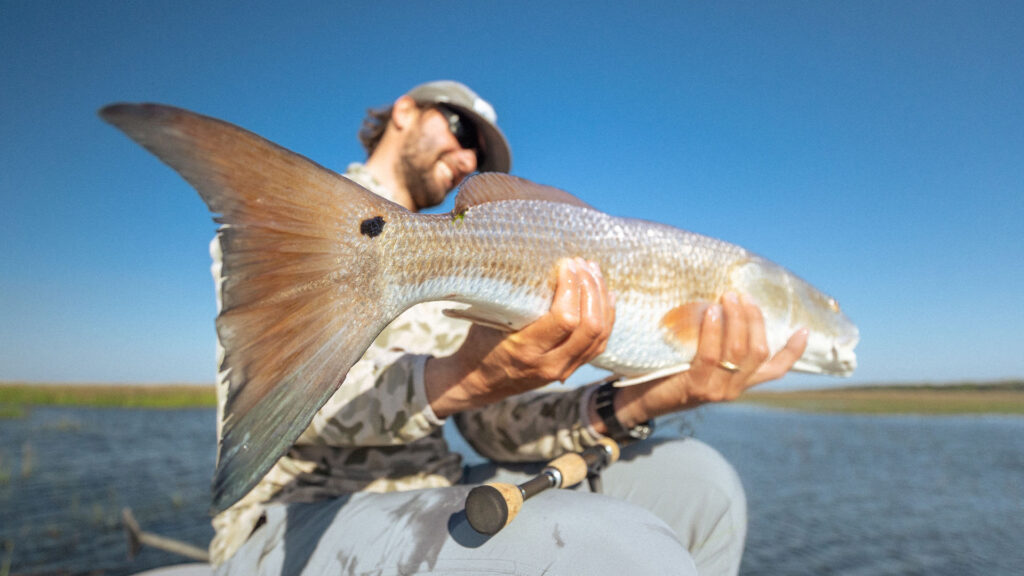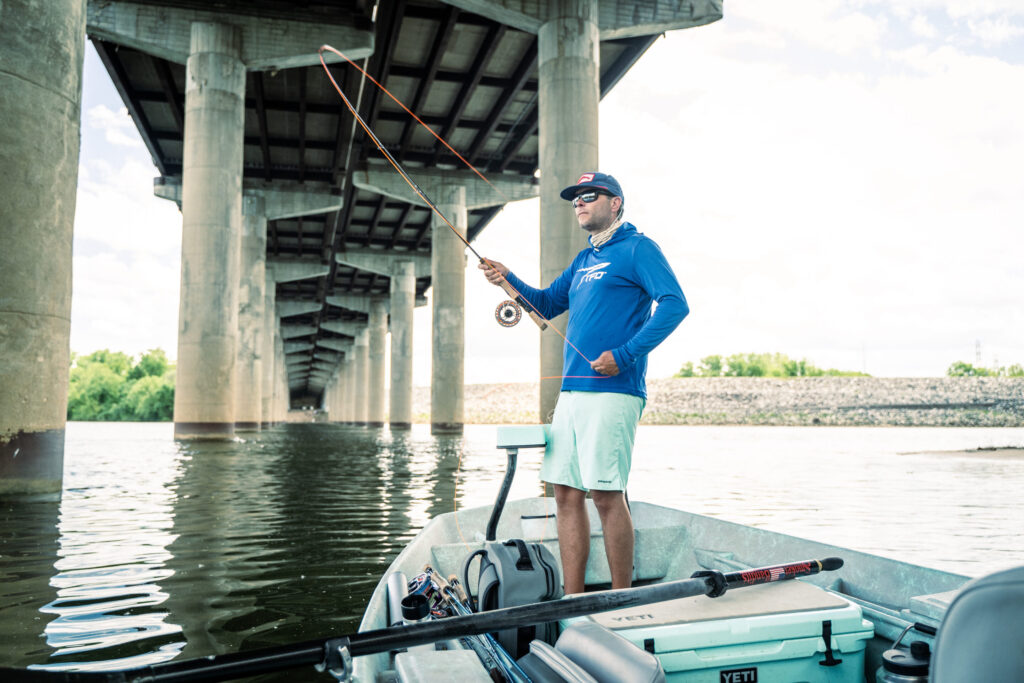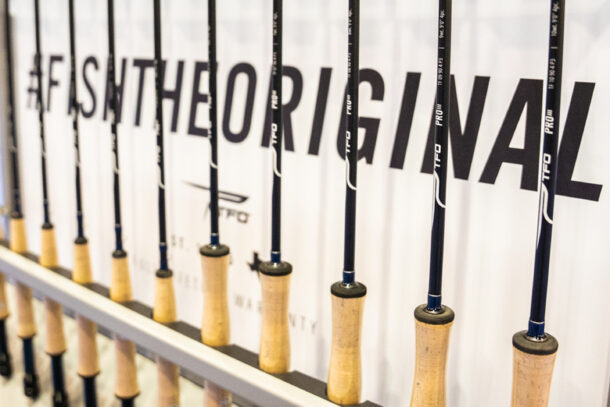In Southeastern North Carolina, the Cape Fear River, a rich and beautiful blackwater river recognized for its very large flounder population, flows 191 miles all the way to the Atlantic Ocean where it empties near Cape Fear. In 2018, Hurricane Florence hit coastal North Carolina causing catastrophic damage to the homes and fisheries in the area, but particularly – the Cape Fear River.
In addition to the substantial amount of flooding, other factors contributed that led to the almost complete disintegration of the aquatic life – resulting in some serious efforts from local fisheries and organizations to place a ban on harvesting flounder in the river for a year. After a year of prohibiting the harvest of flounder and letting nature takes its course, the Cape Fear River is now thriving with some very large and healthy flounder, and guides like TFO Ambassador Stuart Caulder couldn’t be happier.
This Sunday marks the end of the moratorium and the start of flounder season. We decided to catch up with Stu to talk about this exciting time for him and the anglers in this area to find out more about how to find and catch these hard fighting flatfish.
This Sunday, August 16th is the opening day for flounder season, but for the last year, harvesting flounder was not permitted. Can you talk about what factors went into implementing those regulations?
What we’ve had here is a moratorium on keeping flounder since last year. It opens back up this Sunday, August 16 and runs through September 30. Two factors prompted the suspension of harvesting flounder for the past year.
1) Shrimp Boat Trawlers – We still have a lot of inshore shrimp trawlers in this area. As the shrimp boats drag and trawl bottom to collect shrimp, they are also picking up a lot of other species – especially flounder. When the nets come up to the boat for the boat hands to unload, the fish are already worn out, and since collecting and icing the shrimp are the main priorities for these shrimp boaters, the bycatch flounder often get neglected or put off for several minutes while out of water, and most end up dying before they get tossed back over board.
2) Hurricane Florence – With the massive amount of rain and floods we got from Florence in 2018, the waste ponds on the pig farms upriver flooded, resulting in a large bacteria bloom. This took out all of the oxygen in the river, and basically killed millions of fish.
With these two factors, and because the flounder population had been decimated so bad, the North Carolina Division of Marine Fisheries put a moratorium on the species for a year.

A cloudy but beautiful day on the Cape Fear River in Southeastern North Carolina. Photo: Stu Caulder
Were there any other species that were largely affected by both Hurricane Florence and the hog farm flood aftermath?
Oh yeah – trout, redfish and stripers. Right after the storm, it pretty much decimated our striper fishery for the winter. They’re coming back now, but there’s only the small ones left where they’ve restocked the river. A lot of the fish either left to the ocean or died. You could see thousands of them floating down the river after Florence.
How did the year long moratorium effect the flounder population on the Cape Fear River?
It’s actually rebounded remarkably! A lot of the fish that were close to the mouth of the river could get a sense for what was going on when Florence hit, and they ran offshore. After the storm, they came back up the river, and with the moratorium in effect, these fish have basically sat here for a year and have gotten big.
It’s nothing to get your limit and get a few 3-4 pounders now. An 8 pounder is definitely not out of the question, and there have already been some 10 pounders caught as well. It’s really early for some of those big ones, but it’s a great sign that they’re already in here. It’s go time!
That’s great news! Let’s talk fishing set-ups. Are you using conventional or fly when going after flounder?
The majority of the flounder fishing I’m doing is conventional, and I typically use artificial bait because I can usually cover more ground than I can with live bait. With live bait, you have to slow way down, and you can’t fish it as fast. I’d rather pitch fast and work the grass banks on high tide and just pitch, pitch, pitch.
I like to use bucktail baits with some type of scented trailer behind it. It can be a DOA bait, or a gulp bait – something that has some smell to it. The ones you’re after are going to eat that bucktail. The bigger flounder are very aggressive and they don’t have any problem popping those bucktails, as long as there’s a scented trailer. They really like a scented trailer.
The rod that helps me get this done is the TFO Inshore 7’ Medium. The bucktails I’m throwing are usually between 3/8 – 1/2 oz. in weight. I like using the Inshore Medium as it has a little bit more backbone compared to the Medium Light. Every now and then, you’ll pick up a drum with that same flounder bait, and sometimes the drums you’ll get into are pretty big and can put a work out on those smaller rods. The Medium is a great tool for handling those larger fish.
The 7ft works great because it’s long enough to make a nice long cast, when needed, but short enough to pitch baits tight to the bank, as well. For a reel, I’m using a Penn Conflict in a size 30 with 15lb. Berkley Ultra Cast braided line, and then I use a 20-30lb fluorocarbon leader because they have got some teeth; especially those bigger ones!
Inshore Tarpon – I also like to have a Seahunter rigged up when fishing inshore, because every now and then, you’ll have tarpon roll up on you, and you just can’t pass up the opportunity to cast to a tarpon.
I like to have a Seahunter SHS 7030 rigged up with a Diawa BG 5000 size reel loaded with 50lb Berkley Ultra Cast braided line. For bait, DOA makes a Big Fish Lure, it’s a 5.5” soft plastic swim bait that suspends about 2 feet under the water. You can snap the rod tip a few times and that bait will just sit there and suspend. That’s a great setup for inshore tarpon fishing.

Fishing the drop offs near grass edges can be very productive. Photo: Oliver Sutro
What type of forage food do the flounder key in on this fishery?
Typically, what I find them eating are small baitfish patterns such as small spots, croakers, or popeye/finger mullet. They’ll also eat a lot of shrimp. I don’t get a lot of crabs out of them. So mainly that’s what I’m mimicking, and that’s what the bucktail bait is used for.
Sometimes, a 7-8lb flounder can eat a 6-7 inch baitfish. You can throw a big bait in an area where you know there’s fish and usually bypass the smaller ones to go for a 3-4 pounder or bigger.
Do you typically just stick to white patterns to imitate baitfish?
Mainly white bucktails, and sometimes I’ll switch it up on my trailers. I may run a trailer that’s white on one, then maybe run a chartreuse trailer on another. A lot of that will depend on the water clarity. Sometimes I run a root beer color trailer, something dark. If the water is real dark and dingy, I’ll run dark baits. If the water’s real clear, I’ll run lighter baits.
How are you targeting flounder? In other words, where are you looking for them in the inshore areas within the Cape Fear River?
Flounder aren’t too spooky, it’s not like you’re sitting a really long distance off the bank and casting to them, I’m fairly close to the bank and all I’m doing is just making little underhand pitches. I’m working that first five feet of grass line on high tide. Once you’re out about 5-8 feet, bring it in, then pitch it back over to your next spot, work it out, etc.
It’s almost like bass fishing. They’re going to go right up to that cover and stay there, cause that’s where all the food is. So once you’re back out past that 5-8 feet zone, bring it in and pitch it back in there. The more time you spend in that “hot zone”, the better off you’ll be and the more fish you’ll catch.

Flounder fishing is a blast for any angler. Photo: Stuart Caulder
Do those larger flounder tend to stick to deeper areas/drop-offs?
It’s mainly tide oriented here. We have about six feet of tide. So on high tide, all the fish push right up to the grass banks/edges. The water on all the grass banks will be at about 3 feet, but they’ll be right up on the grass edge. Now when the tide falls out, and we get to lower tide, that’s when they go to the drops and go from 2 feet to 6-8 feet in the creeks. If you go to the main river, you’re dealing with more of a 12-15 foot drop off.
For the most part, I stick to targeting flounder around high tide. I like to fish the grass edges cause I like to move. When I do go to the deeper spots, a lot of the time I’ll position my boat, throw to the shallows, and just bounce that bucktail right down the shelf. Usually they’re on the slope, or they’re right at the bottom, or they’re right at the top. They’re usually around that release somewhere, so once you get way out off of the release, then you might as well just bring it back in and get back on top of the shelf.
Do you use any type of bobber or indictor to detect a strike?
I don’t. The strike is fairly firm. They’re pretty aggressive, especially with the amount of current we get here. Even if I were fishing somewhere where there isn’t much current I still wouldn’t use a bobber or indicator, because you have to make sure you’re freely getting to the right depth.
With the 7′ Medium Inshore rod accompanied with a braided line combo, it’s very sensitive. You feel everything. You’re definitely going to feel the bite.

Heading towards the offshore wrecks. Photo: Oliver Sutro
How about offshore fishing for flounder? Are you doing much of that, and what setups do you typically use in that scenario?
I like to fish the wrecks offshore, and when I do, I like to make sure I have a few of the Seahunter rods with a couple of different baits rigged up in case a cobia, or a jack, or season king mackerel swims up on me. A lot of times when you bring these flounders up off the wrecks, the cobia will follow them straight to the boat. And when they do, just leave the flounder in the water, take your other bait on that Seahunter rod, then pitch it to them. Usually the cobia will hit it. As soon as he hits that bait, bring the flounder in, then you’ve got the cobia as well. That way you can get a double bang for your buck in that type of fishing.
I think what’s happening is this scenario is that when the flounder are on that way up to the boat, they’re spitting stuff up, and the cobia is just picking that stuff off. Except in the scenario where the cobia is bigger than the flounder, and the flounder just gets eaten.
Pro Tip For Offshore Flounder Fishing – Always have a Seahunter rod ready and rigged up for when you do hook into a flounder for this very reason.
For my Seahunter set up, I’m using the SHS 7030 – so the 20-30lb line size model, and I like the 7 foot version. I run a Daiwa BG 5000 reel with 50lb Berkley Ultra Cast braided line. For my baits, I typically use a big bucktail, or sometimes even a big swim bait. That way if I have another fish follow the first flounder, I can usually just drop it in the second fish’s face and they’ll pop it.
Another way to locate and target flounder off shore, which usually involves using scopes and electronics, is targeting what we call Flounder Hotels. What they are is a big cement dome with holes in it, and the flounder love them. Once you locate one and mark it on the screen, you can usually use a 1oz. buck tail. Fire that sucker down there in about 30-40 feet of water to where it’s near the parameter of those domes/hotels, and the flounder will come out of those holes and pop that bait.

You never know what you’ll find while offshore fishing. The Seahunter has the backbone and lifting power to handle almost any species. Photo: Oliver Sutro
Would you rather fish for flounder in the rivers or offshore?
I prefer to fish the river because that’s where the big ones are. Not that you won’t catch some nice ones offshore. There’s probably more numbers offshore in the 3-5 lb. range, but the bigger fish are in the Cape Fear River.
Any words of wisdom/tips you want to leave with our readers related to flounder fishing that we haven’t gone over?
The main tip is to be patient, and as you make long drifts down the banks, remember where your bites were. What you’ll find is that you may cover a quarter to half mile bank and get all your bites in a little 200 yard area. Once you fish that long stretch and are able to access where those bites were, go back over that area again, because most likely all those fish have oriented themselves to that particular area for that particular day. Just go back and go through those hot spots two or three times, move on to your next stretch and search it out the same way. Rinse and repeat.

Interviewee/TFO Ambassador Stu Caulder with a NC redfish. Photo: Stu Caulder
Stuart Caulder is a TFO Ambassador based out of Wilmington, North Carolina. He runs Gold Leader Guide Service where he primarily fishes the Cape Fear River in search of flounder, drums, and stripers, but also offers offshore charters as well. To contact Stuart for a trip, find him on Facebook and Instagram, or shoot him an email.
![]()
